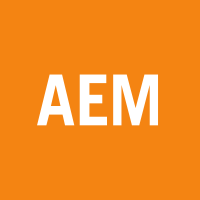Agnico Eagle Mines
| Agnico Eagle Mines Limited
|
|
|---|---|
| legal form | Limited |
| ISIN | CA0084741085 |
| founding | 1953 |
| Seat | Toronto , Canada |
| management |
|
| Number of employees | 9,188 |
| sales | $ 2.243 billion |
| Branch | Mining |
| Website | www.agnico-eagle.com |
| As of December 31, 2017 | |
Agnico Eagle Mines Ltd. (short AEM ) is a mining company for gold mining in Canada , headquartered in Toronto , Ontario . The company is listed on the S & P / TSX 60 stock index on the Toronto Stock Exchange .
Agnico Eagle Mines is primarily active in northwest Canada in the provinces of Québec and Ontario . New projects outside of Canada have started in Kittilä ( Finland ) and Pinos Altos ( Mexico ). In 2013, the company produced a total of around 1.1 million ounces of gold and 4.6 million ounces of silver . In 2015 Agnico Eagle Mines operates nine gold mines.
history
In 1953, five mining companies joined forces to form Cobalt Consolidated Mining , which was renamed Agnico Mines in 1957 . The name Agnico is an acronym and consists of the element symbols for silver (Ag), nickel (Ni) and cobalt (Co). In 1963 Paul Penna was named chairman of the company.
In 1972 Agnico Mines merged with the mining company Eagle Mines to form the group that still exists today. Agnico-Eagle Mines was chosen as the new name . In the same year, the company's shares were first issued and traded on the Toronto Stock Exchange , the Canadian stock exchange. With the merger, the "Joutel" mine complex in northwestern Québec fell into the possession of the new group.
Gold mining in Joutel began in 1974 and lasted until 1993. In total, approximately 1.1 million ounces of gold were produced in the mine complex ; in addition, up to 410,000 tons of iron ore were extracted annually in the complex . In 1989, Agnico-Eagle Mines took over Dumagami Mines , another company that owned mines in Québec. Through further acquisitions in the years that followed, AEM was able to acquire further large gold deposits in Québec.
Agnico-Eagle Mines first began gold mining in countries outside of Canada in 2005 by acquiring Riddarhyttan Resources AB , a Finnish mining company, including the Suurikuusikko (Kittilä) deposit. Since 2006, the company has also been involved in gold mining in Mexico.
In 2013 the company removed the hyphen from the company name and has been operating as Agnico Eagle Mines ever since .
In 2014, Agnico Eagle Mines and Yamana Gold acquired Osisko Mining Corporation and partnered with Yamana Gold to operate the Canadian Malartic mine, the largest gold mine in Canada.
production
In 2014, the company operated a total of nine producing mines worldwide.
| Surname | country | proportion of | Production 2014 in oz |
Reserves (P + P) in 000 oz |
Cash cost in US $ |
|---|---|---|---|---|---|
| Canadian Malartic |
|
50% | 143,000 | 4,329 | $ 701 |
| Creston Mascotta |
|
100% | 47,800 | 236 | $ 578 |
| Goldex |
|
100% | 100,400 | 340 | $ 638 |
| Kittila |
|
100% | 141,700 | 4,524 | $ 845 |
| La India |
|
100% | 71,600 | 679 | $ 487 |
| Lapa |
|
100% | 92,600 | 170 | $ 667 |
| LaRonde |
|
100% | 204,700 | 3,432 | $ 668 |
| Meadowbank |
|
100% | 452,900 | 1,168 | $ 599 |
| Pinos Altos |
|
100% | 171,000 | 1,763 | $ 533 |
| total | 1,429,000 | $ 637 |
Source: Agnico Eagle Annual Report 2014
Web links
- Agnico-Eagle Mines Ltd. website English
Individual evidence
- ↑ Management
- ↑ a b Agnico Eagle Mines 2017 Form 40-F Report , accessed October 21, 2018
- ↑ Key facts. Agnico Egale Mines, accessed February 16, 2015 .
- ↑ a b c company history. Agnico-Eagle Mines, accessed February 16, 2015 .
- ↑ Property Joutel Project. Visible Gold Mines, accessed February 16, 2015 .
- ↑ Further key figures on Agnico Eagle. Retrieved January 10, 2016 .

